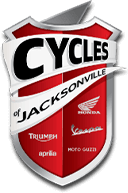Motorcycle Hearing Protection
 Exposure to loud noise will inevitably cause hearing loss over time. The good news is our ears can recover from short exposure to loud noise. The bad news is the longer and louder the noise, the greater the chance that permanent hearing damage will occur. Straight off the bat, Harley-Davidson motorcycles are known for their extraordinarily loud growls. It doesn't matter what make, model, or style of Harley motorcycle you have: these bikes make a lot of noise.
Exposure to loud noise will inevitably cause hearing loss over time. The good news is our ears can recover from short exposure to loud noise. The bad news is the longer and louder the noise, the greater the chance that permanent hearing damage will occur. Straight off the bat, Harley-Davidson motorcycles are known for their extraordinarily loud growls. It doesn't matter what make, model, or style of Harley motorcycle you have: these bikes make a lot of noise.
Here at Cycles of Jacksonville, we want to stress the importance of motorcycle hearing protection for all riders. Continue reading to learn more about why hearing protection on your motorcycle is so important and how you can incorporate it into your riding.
The Importance of Hearing Protection
When you’re passionate about motorcycle riding, you’ll undoubtedly spend much more time on your motorcycle. The cumulative effect of subjecting yourself to all that noise may be doing more damage to your hearing than you might expect. There is no such thing as simply toughening up or “getting used to it.” The combination of noise from the motorcycle and the highway noise increases your risk of incurring hearing damage.
Exposure to noise levels above 115 decibels or dB, a unit used to measure sound volume, for even five minutes is risky. Scientific studies have shown that hearing loss can occur when one’s average noise exposure over an eight-hour period exceeds 85 dB. Motorcycle noise volume has been limited by the government to be no louder than 84 dB while traveling over 35 mph, but this is still very loud.
Below 35 mph, the biggest noise contributor is your motorcycle’s engine. However, above that speed, it’s the wind speed itself that will do damage to your hearing. You may think that your helmet will reduce noise, but unfortunately, your helmet can vibrate at higher speeds and add to the noise. This is why hearing protection is so essential!
Different Types of Hearing Protection
They are many types of hearing protection available to you, including earmuffs, earplugs and ear caps. All hearing protection is designed to reduce the decibel levels of noise around you, but some forms of protection are more effective than others.
For a motorcycle rider, your first consideration when choosing hearing protection is how well it will function with your helmet. For instance, ear muffs won’t work because of their stiff band and the fact they fit over the outside of the ear. Earplugs, ear caps and shaped wax are all much better choices for a motorcycle rider. We’ve outlined the pros and cons of each style below.
Earplugs
Earplugs are made of foam, rubber or plastic and inserted into the ear canal. They’re either one-size-fits-all or available in different sizes. Earplugs are lightweight and require no maintenance, and they can reduce noise levels by up to 30 dB. Try several different sizes, types and brands to find the perfect fit. These are the most protective of the three options.
Ear Caps
Ear caps are similar to earplugs except that they aren’t inserted into the ear canal. Instead, they rest on the outer shell of the ear, blocking sound externally. The main disadvantage to ear caps is that they are not as protective as earplugs.
Shapeable Wax
Shapeable wax can be rolled into whatever form you desire, making it easy to custom-fit to your ear canal. However, the wax can feel greasy when used on hot days because of its propensity to melt. Ultimately, the type of hearing protection you choose will depend on your own personal preferences.
How To Use Hearing Protection
Each type of hearing protection comes with its own instructions for use. If you choose to wear foam earplugs, follow the following steps:
Roll and Compress
Squeeze or roll the earplug between your thumb and forefinger to form a compact cylinder.
Insert
Use your free hand to reach over your head and pull up the top of your ear. This will help open up your ear canal for easy insertion. Gently insert the earplug into your ear canal. If you start to feel pressure, don't push any further. The foam will expand to completely block your ear canal.
Repeat
Repeat the process with your other ear.
Make sure not to push the plug hard when inserting the cylinder, you may damage your ear canal. Also, for the earplug to properly be inserted, the bottom edge should be located at the opening of the ear canal. Don’t leave a portion of the earplug in the ear canal because this will reduce effectiveness.
Motorcycle hearing protection is essential for all riders. Don’t forgo it and put your hearing at risk! Damage occurs much more quickly than you expect, so taking preventative measures early on will help you keep your hearing while enjoying every ride.
In the market for a great motorcycle? Maybe you want to talk shop with our mechanics. Stop by Cycles of Jacksonville today to see our wide selection of new and used motorcycles for sale. We can also assist you with motorcycle parts and repair services! Our dealership is located in Jacksonville, near St. Augustine and Orlando, Florida.
